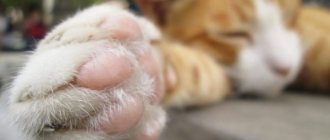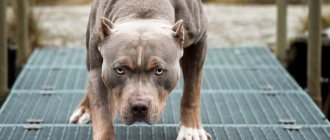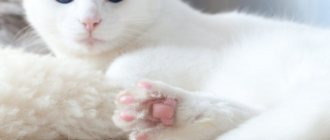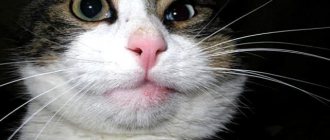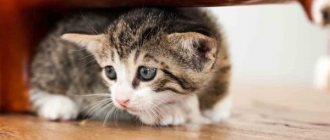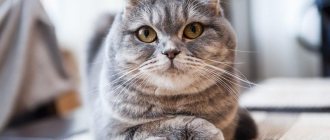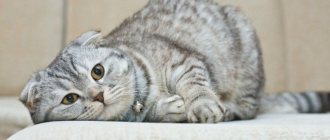Cats are particularly mobile. This may also result in some injuries. If a cat is limping on its front leg, the owner should definitely find out the cause of the problem and provide quality treatment to the animal. Without this, there is a high risk that the damage will not go away on its own, and the pet’s condition will continue to worsen. The owner can determine on his own the reason why the front leg is limping only if there are external signs of a violation of the integrity of the limb. In other cases, only a veterinarian can make the correct diagnosis.
There is one non-pathological reason when a cat's front (or back) paw is lame. It occurs if the animal has an artistic streak and a touchy character. Such a cat, if the owner even slightly stepped on his limb or slightly pinched it with the door, and everything happened without injury or damage, immediately uttering a very loud cry, begins to limp on the injured paw, demonstrating with all his appearance that he is a victim.
After examining the limping paw, the owner does not detect any pain or signs of damage. The animal will demonstrate an abnormal gait for another 2-3 hours, after which it will stop the performance. The main thing at this moment is not to feed the cat treats, as otherwise it will get used to this method of extortion.
In other cases, the cat's front paw is lame for pathological reasons that require treatment. The following several diseases and injury are the main factors causing front paw lameness .
- Trauma . The most common reason why a cat limps on his front leg if he walks freely on the street. Lameness does not necessarily occur due to a severe injury, such as a fracture or dislocation. Impaired movement of the front paw can also occur due to bruises, cuts, splinters and sprains. During an external examination, you can detect a wound or swelling that causes the front paw to limp. If a cat suddenly limps, then in 99% of cases there is an injury. If it is simple, then nothing needs to be done, and it goes away in 2-3 days. The most serious damage occurs to a kitten if it is attacked by a dog. If the animal begins to limp gradually, there is no talk of injury.
- Osteochondrosis can also cause lameness in a cat. The disease occurs in older cats. In pathology, pinching of the spinal cord roots occurs. If this pinching affects the cervical region, then the cat has one front paw or both paws lame. It is very difficult for him to stand on them. It is impossible to completely cure the pathology, and therapy is exclusively supportive in nature. The older the pet, the more severe osteochondrosis will manifest itself, causing more and more pronounced lameness. Often this is the answer to the question why a cat is limping.
- Elbow dysplasia . The disorder occurs infrequently and mainly in especially purebred cats, whose external appearance is much more important than health. This disorder begins to manifest itself in young cats and only intensifies over the years. Such individuals should not be bred, since the pathology is hereditary and is passed on from parents to offspring. The left or right paw is lame, or both at once. The pathology begins to manifest itself most clearly when the cat is two or three years old.
- Arthritis or arthrosis . Diseases that occur in older cats and lead to inflammation of the joints. The pathology affects the fore and hind limbs equally. Lameness increases gradually. Treatment for this disease is predominantly supportive. There may be periods of complete elimination of symptoms and their subsequent reappearance. The cat's lameness does not disappear completely. If therapeutic measures are not taken, the pet’s condition will only worsen and it may completely lose the ability to move normally.
- Osteomyelitis . Occurs in cats less than 2 years old. In pathology, partial destruction of the paw bones occurs with the development of a purulent-inflammatory process. The cat has a limp front leg, both legs, or the back legs too. The disease is especially common in representatives of the Persian breed and animals bred on their basis. The main assumption regarding the causes of the disease is genetic predisposition.
If a cat or cat is limping on its front leg, urgent measures must be taken to eliminate the problem. The longer a visit to the veterinarian is postponed, the more money will need to be spent on treating an already advanced disease. The veterinarian will take an x-ray of the front paws and, after identifying the cause of the pathology, prescribe the necessary treatment. The front paw of cats is especially functional, and therefore when it is lame, the pet experiences serious difficulties and cannot continue to live a full life.
A healthy cat is an active animal; it still lives exclusively at home or goes out for a free walk. Such activity can lead to a number of injuries, for example, lameness on the front leg. Often this is not an independent disease, but a clear symptom of the presence of other hidden diseases.
How can you tell if your cat has front leg lameness?
What is it - lameness or a fracture of the front paw?
Everything greatly depends on the health status of the particular pet, the severity of the individual episode, most often the signs are as follows:
- the animal does not step on the sore leg, tries to transfer weight to the healthy limb;
- the cat has an uneven, slow gait;
- does not want to perform the movements that are familiar to her;
- the pet does not allow anyone to touch its sore paw and is in pain;
- The cat endlessly licks the sore limb.
Elbow dysplasia
This disease is not considered the most typical for cats, but... Yes, in the case of outbred “Murks” everything is exactly like that. They practically do not suffer from this pathology; cases are extremely rare. It’s just that in recent years things have been much sadder with purebred cats. The problem is selection. More precisely, in poorly carried out selection: many animals end up in breeding that should not have been allowed there, as a result of which the breed acquires many “bad” genes. The characteristics of the pathology are as follows:
- As is easy to understand, the forelimbs are affected (as a rule, the pathology is well manifested only on one paw).
- The disease is hereditary . If you do not know the breeder, and there are no people among your acquaintances who bought kittens from him, it is better not to take risks. Animals must be purchased only from trusted persons who will not allow sick pets into breeding.
- Elbow dysplasia is diagnosed at the age of two or three years, or even earlier.
- The severity of symptoms varies greatly from cat to cat. Your pet may be lucky, and then he will only be bothered by intermittent claudication, or he may be unlucky, and then without surgery he will not be able to fully move.
Therapy (full) is exclusively surgical . Anti-inflammatory drugs, painkillers, etc. are prescribed only in mild cases when the body’s compensatory reserves have not yet been exhausted. When the cat is already noticeably falling on the sore paw, drug treatment will not give much effect.
Causes of lameness in cats
Examination of the front paw.
When lameness is constant, almost from birth, it can be caused by genetic abnormalities in the very development of the skeleton (dysplasia).
It happens that a cat begins to limp due to a number of metabolic disorders (for example, osteodystrophy). Less common are serious illnesses such as osteosarcoma .
When chroma appears suddenly and there are no visible injuries, its common causes are bruises, dislocations, small cracks and even ligament tears. Even an unsuccessful jump from a small height, such as a chair or sofa, can cause an injury to the cat, causing it to limp. A cat with a small tear of the cruciate ligament may suddenly become lame .
Help for the front paw by a veterinarian.
Another common cause of lameness in cats can be arthritis, nerve or nail disease that affects the sensitivity of the paws.
Lameness in cats and calicivirus
Lameness can also develop due to infection with feline calcivirus.
Already in the first stages of calcivirus, some cats may experience transient lameness, which even got its name - lameness syndrome. Infected cats often react painfully to touching their joints, and there is increased sensitivity to touch.
Other signs of calcivirus: sneezing, runny nose, fever, discharge from the mouth and runny nose, etc.
Many studies indicate that under the influence of calcivirus, a systemic infection sometimes occurs, which causes localization of the virus directly in the tissues of the joint. Thus, calcivirus is quite capable of causing temporary polyarthritis, more often in adults than in kittens.
Ulcers in the mouth are the first sign of calcivirosis.
It should be noted that lameness, directly associated with calcivirus, mainly manifests itself in kittens. In cases where lameness makes itself felt after vaccination, it is most often caused by an acquired infection. True, sometimes the reason lies in the vaccine.
Lameness syndrome
The severity of chromatosis syndrome varies quite widely, ranging from subtle inflammation, slight limping, to a severe form of polyarthritis, when the pet stubbornly refuses to move and refuses to eat on principle.
Typically, affected cats recover on their own over time.
Osteomyelitis
Another dangerous pathology, often leading to the development of lameness in cats. Roughly speaking, this is the name for the process of degeneration and partial destruction of bone tissue. The disease is characterized by the following:
- Osteomyelitis can affect any limb, and more often, two or all four at once.
- It is no coincidence that the disease is known as “growing pain”, since it most often affects young animals that have not yet reached two years of age. Most often, this pathology is diagnosed in representatives of the Persian breed and crossbred animals based on it.
- The cause of osteomyelitis is not precisely known. Most likely, the reason lies in some defective genes . The same “Persians” have plenty of them.
When sick, a cat doesn’t just limp. It is enough to try to feel the sore limb, and you will be guaranteed the thrill of the no less sharp claws of your pet. The cat hisses and howls in pain. Fortunately, therapy consists only of corticosteroids and painkillers, since self-healing occurs with age.
What should the owner do?
If you notice that your pet is limping, the first thing to do is to immediately examine the paw . Perhaps the cause will become clear, for example, damage or a foreign body in the limb itself.
If there are no visible injuries, you need to take your cat to the vet. He will conduct a manual examination and, most likely, the pet will have to undergo x-rays. Only after a thorough diagnosis will it become clear why the lameness occurred and how serious the situation is, will a treatment strategy for the cat be proposed.
Diagnostic methods
Diagnosis of osteochondrodysplasia in Scottish cats is carried out on the basis of a visual examination, as well as a study of the animal’s pedigree. In addition, to make a final diagnosis, the veterinarian will prescribe the following tests:
- General and biochemical blood test.
- General and biochemical urine analysis.
- X-ray examination of the limbs, spine and tail.
In the image of a cat with osteochondrodysplasia, you can see the deformation of the skeleton, and in the area of the limbs you can detect growths around the joints, while the gaps between them are very narrow. In severe cases of the disease, cartilage tissue is absent, and the vertebrae in the lumbar and caudal regions grow together.
Scottish fold cat
Fans of unusual cats should take a closer look at this breed of cat, because they are not only beautiful, but also interesting in their attitude towards adults and children. They have many features that it is recommended to familiarize yourself with before purchasing, to know exactly what you can expect from them and how to properly care for them.
Cats, cats and kittens of this breed are described in detail in this material, collected in the form of answers to frequently asked questions about the breed from those who have not yet encountered them and want to understand whether or not it is worth getting such a pet.
The peculiarity of this cat is expressed in the name of the breed - Scottish Fold. Folding ears are unusual for cats, but this shape of the ears transformed the appearance of the animal and the defect, thanks to this, gave impetus to the emergence of a new breed, registered as the Scottish Fold.
The standard representative of the breed is of medium size, rounded body, slender paws. The muzzle is rounded, smoothly turning into the neck. The nose is wide and short. The eyes are large and wide open. The ears are directed forward and their tips are slightly rounded.
The disadvantage of Scottish Fold cats is their fragile health, weak bones, wayward and somewhat selfish character. However, with proper care and education, these shortcomings can be easily eliminated.
The Scottish Fold cat is so attractive that not only children who generously express their emotions, but also “respectable” adults want to caress and cuddle it. However, if a cat becomes pregnant, in order to avoid complications and a successful outcome of pregnancy, it is better to handle the cat less, isolate it from children and protect it from all kinds of stress.
The duration of pregnancy in Scottish Fold cats is 65 days ± another 2-3 days. Childbirth, as a rule, lasts a total of about 12-24 hours and in healthy animals occurs without
Source
Enter the site
Search form
Our services
Cases from practice
They are asking for help
Lameness in cats
Sometimes it happens that a cat that seems absolutely healthy at first glance suddenly begins to limp on its front or back leg. In such cases, many caring owners will immediately begin an inspection for damage to the pad: they will look for a foreign body that causes pain to the animal when walking, a scratch or a cut. Sometimes lameness in cats occurs precisely due to these reasons. But if, when examining your limping pet, you do not find anything like this, you should definitely contact a veterinarian.
Before prescribing any treatment, the veterinarian must find out the reason why the cat is limping. There are a great many of them, but the most common of them are:
1) observation. In this case, the veterinarian visually assesses the severity of the lameness (mild, moderate or severe), its severity, dislocation (the cat is limping on the hind leg or on the front leg, on the right or on the left), frequency, etc.;
Only after a full examination, diagnostic procedures have been carried out and the cause of the pathology has been established, treatment is prescribed to the cat. Treatment can be surgical or conservative. Both are quite effective in each specific case.
But don’t forget about another reason why a cat begins to limp. This is a lack of proper attention on the part of the owner. Don't underestimate the intelligence of these animals. Just yesterday your pet was completely healthy, but in the morning the cat is limping on its front leg? In this case, watch how she runs while playing or, for example, goes to a bowl of food. Perhaps the animal suffered from a musculoskeletal disease, during which you gave it much more
Source
Arthritis and arthrosis
Arthrytis (arthritis) translated from Greek means “joint inflammation.” This is one of the most common pathologies that affects old cats everywhere. Arthritis that affects one joint is called monoarthritis in veterinary medicine, and disease of two or three joints is called oligoarthritis. If not one or two, but all joints of the limbs suffer, then the name of the diagnosis changes - polyarthritis . What is arthrosis? This is the name of an inflammatory-degenerative disease, which is generally characterized by the same pathological changes in the joints.
But its essence does not change. The joints do not hurt so much without movement, without load on them, but more so with load and active games. In this case, the cat becomes very weak, completely or partially refuses to eat, and the body temperature may rise. Arthritis affects not only the joints, but also the internal organs. Among the main reasons leading to the development of the disease, veterinarians identify the following factors:
- Heredity , about which we have already written a lot above.
- A “lying down” lifestyle, that is, pathology very often affects castrates who are prone to low activity and rapid weight gain. If a “well-fed” cat begins to constantly fall on its front paw, it should be taken to the doctor immediately.
- Unbalanced diet. This is typical for pets whose owners “don’t bother” with choosing the right, complete diet.
- We can also mention our ecology, which has a detrimental effect on the health of not only humans, but also their pets.
- Various infections .
Scottish fold cat limps on its front leg
The cat is limping on his front leg
In the morning everything was fine, I left for 3 hours, and when I returned, the cat was limping. And he doesn’t eat (she offered a tasty treat, which she never refused)
There was contact with a kitten (hugged, licked her, possibly ate from the same bowl), which either had stomatitis or calicivirus. Today we were taken to the clinic. I was planning to go and get some serum for him now.
I found an article on the Internet about this. I quote “In most cases, if a cat or dog is limping on a back or front leg, then there is nothing terribly terrible here, the veterinarian reports, this phenomenon may pass in the near future. Your dog or cat may limp for a few days, then the lameness will gradually subside. If the pain is severe or if the lameness continues for more than three days, you should call your veterinarian. "
What exactly is the question itself? Should I go or is it better to wait? I’ll do the serum tomorrow, now I’m watching the cat. (mouth without ulcers, gums normal)
First of all, I will say that Marcello (that is the name of the hero of my review) is our family member and the truth will be expressed on the basis of him, other familiar owners of the Scottish breed, the study of many articles and medical reports.
Let's get acquainted! This cheeky beast is Marcello, a one-year-old Scot. A handsome, stocky man who considers himself the king of the apartment, the pastel lord and the lord of the tiles in the toilet (I will explain why below).
The first three days were difficult: the kitten did not want to be toilet trained. Everything was described, including the owner's slippers. The rags with his urine in the tray and my half-hour guard at his toilet did not help. Only then, on the fourth day, while peeing in flight, she sat me down in the tray and that was the end of the torment.
From the first day Marchik began to show his character: he did not sit in his arms, did not give
Source
The cat is limping on his front leg
Three weeks ago the cat began to limp on his left front leg, then a week ago they noticed that when he sits, he tucks his leg in and holds it suspended. He limps more severely after sleeping or lying down for a long time, in general, subjectively, he began to sleep more. He doesn’t refuse food, he runs and plays with the older cat up to the ceiling. During an external examination, no wounds, bites or ingrown claws were found. An x-ray was taken at the veterinary clinic (pictures are attached). In the first picture, the veterinarian pointed out a sharp growth near the joint capsule.
Veterinarian No. 1 recommended Stride Plus as a preventative measure (take according to instructions). He said that these might be the first signs of dysplasia. And that without treatment, the fragment (in photo 1) can get into the joint capsule and injure the joint.
Veterinarian No. 2 said that she was not a specialist in orthopedics, but suggested, as an option, Tolfedin or Chondartron for 7-10 days or Stride Plus, and additionally recommended rest for the animal and an in-person consultation with an orthopedist. Unfortunately, we do not have such specialists in our city.
The cat is kept at home, never goes outside, neutered at the age of 10 months, eats dry Yams food (until 6-7 months he ate dry Royal Canin for the British). The cat had not been sick before. I was vaccinated only with the first two vaccinations with the Nobivac tricat trio vaccine.
None of our veterinarians made any diagnosis, citing the need for some more detailed examination of the joint, during which fluid is injected and an X-ray is taken in several projections under anesthesia.
Elbow dysplasia in cats (this is an inherited condition of the joint). As a therapeutic measure, it will be sufficient to use chondroprotectors (stride or analogues in injections if stride is not effective), as well as losing excess weight.
Elbow dysplasia in cats (this is an inherited condition
Source
ZooForum: Scottish Fold cat is limping – ZooForum
(others can give advice in a PM, indicating that the advice is not given by a veterinarian. But the forum is not responsible for THESE advice.)
The Scottish Fold cat is limping, limping alternately on different paws
I was always very strong and healthy, never injured myself. I'm lazy by nature. Doesn't run around the apartment at all, has never jumped higher than the sofa.
he has been limping for about the last month, immediately after moving to a new apartment he began to limp, I thought maybe it was a splinter or something, but I kneaded all of his paws, felt everything between his toes, it doesn’t hurt him at all and everything seems to be fine, but when he gets up and starts walking, then limps. What does his limp have to do with flickering. that is, sometimes not, sometimes on the front paw, sometimes on the hind paw. He limps, walks and seems to walk, even runs sometimes without limping. Lameness mainly appears after sleep or when lying down for a long time.
no suspicion of kidney problems? for dysplasia? Have you examined the claws, are there any ingrown ones? damaged? Are there any suspicions of spinal problems?
No, I trim my claws regularly, but so sparingly, not to the root. Everything seems to be fine with the spine, it doesn’t ache when you stroke it or pick it up, but maybe you can somehow check??
Regarding the kidneys, this is the first time I’ve heard about it. and what lameness could this cause?? Then you need to get tested if it’s kidneys. but damn why did your kidneys suddenly get sick? =(((
Today I found a pink spot on his ear... as if from scratching, but he didn’t scratch his ear. Maybe it’s eczema or some kind of fungus, the ears themselves are clean.
Rimadyl - in what dosage is it prescribed? How much does a cat weigh? Strange course - 3 days. Usually both the manufacturer and doctors recommend a minimum of 1-2 weeks.
She said that this often happens with folded cats. either osteochondrosis or arthritis. It’s somehow indistinct, but I’ve already read all about the visloushki. they write that they often
Source
The cat is limping on its back right leg! what to do.
Good afternoon. My cat (Scottish fold) is 9 months old. About 2 months ago she started limping on her right hind leg. She eats well, goes to the toilet as usual, there are no visible symptoms. Playful, she jumps from the windowsills, and yet at the same time, she sits on her side and stretches her paw forward, and when walking, she steps on it not completely and not confidently. When I touch her paw and generally the back part, she meows a lot and bites, but this was the case even before she started limping. He walks a little and sits down. They took him to the vet right away on the 3rd day and said that the ligament sprain will go away. But it’s been 2 months and it hasn’t gone away. I feed him meat, fish and milk. I also started giving him calcium. I don’t know what to do. Please advise.
Have you gained a lot of weight? Usually the British are large and grow quickly, which puts stress on the joints. There are special vitamins with chondroetin and glucosamine
The Scots have a hereditary disease - osteochondrodysplasia. This is exactly how it manifests itself in the initial stages. I advise you to contact a good veterinarian.
'Osteochondrodysplasia is an inherited disease characterized by skeletal deformities. Sick cats begin to limp, develop a reluctance to jump, and develop a stiff, “stilted” gait. Such difficulties arise due to progressive osteoarthritis, which is a consequence of defective development and dysfunction of cartilage.
Most often, owners consult a doctor due to developed lameness in the pelvic limb or thoracic limb. Often such lameness goes away on its own without any treatment for a certain period, then recurs again, sometimes on a completely different paw. The light weight of the animal helps the cat redistribute the load onto healthy limbs. And although this problem appears in cats before they are one year old, significant
Predisposing factors and how to combat them
Currently, not everything is known about the causes of arthritis. It has many varieties, among which it should be noted: osteoarthritis, gout and rheumatoid arthritis . Each type has its own characteristic features, but at the same time, there is also a lot in common between them: pain when moving, severe lameness, inflammatory processes. The latter (in especially advanced cases) can lead to the development of sepsis and complete destruction of the joints.
There is also “occupational” arthritis. This type of pathology is characterized by the fact that pathological changes in the joints occur as a result of many years of repeated stress on the limbs. For example, chronic arthritis can occur (due to the specifics of the “profession”) in circus cats. But this, of course, is truly exotic. Much more often, the causes of arthritis and the lameness it causes are much more commonplace.
Often the disease is provoked by a cold infection, severe bruises and bites in the joint area , and constant contact with toxic substances. Sometimes an exclusively fish or “dry” (that is, the cat is fed only dry food) diet contributes to joint disease. Rare cases of psychosomatic arthritis appearing in particularly sensitive pets against the background of serious stress (after sterilization, for example) have been described.
How does the disease manifest? The cat begins to limp heavily, every movement causes her severe pain. The joints may become noticeably swollen, and when palpated, it is easy to notice an increase in local body temperature. As a rule, animals react aggressively to attempts to probe them: they meow hoarsely, try to scratch the owner and run away.
Why is a cat limping on its front leg without visible damage, what should I do?
A healthy cat is an active animal; it still lives exclusively at home or goes out for a free walk. Such activity can lead to a number of injuries, for example, lameness on the front leg. Often this is not an independent disease, but a clear symptom of the presence of other hidden diseases.
How can you tell if your cat has front leg lameness?
Causes of lameness in cats
When lameness is constant, almost from birth, it can be caused by genetic abnormalities in the very development of the skeleton (dysplasia).
It happens that a cat begins to limp due to a number of metabolic disorders (for example, osteodystrophy). Less common are serious illnesses such as osteosarcoma .
When chroma appears suddenly and there are no visible injuries, its common causes are bruises, dislocations, small cracks and even ligament tears. Even an unsuccessful jump from a small height, such as a chair or sofa, can cause an injury to the cat, causing it to limp. A cat with a small tear of the cruciate ligament may suddenly become lame .
Another common cause of lameness in cats can be arthritis, nerve or nail disease that affects the sensitivity of the paws.
Already in the first stages of calcivirus, some cats may experience transient lameness, which even got its name - lameness syndrome. Infected cats often react painfully to touching their joints, and there is increased sensitivity to touch.
Many studies indicate that under the influence of calcivirus, a systemic infection sometimes occurs, which causes localization of the virus directly in the tissues of the joint. Thus, calcivirus is quite capable of causing temporary polyarthritis, more often in adults than in kittens.
Source
In the morning everything was fine, I left for 3 hours, and when I returned, the cat was limping. And he doesn’t eat (she offered a tasty treat, which she never refused)
There was contact with a kitten (hugged, licked her, possibly ate from the same bowl), which either had stomatitis or calicivirus. Today we were taken to the clinic. I was planning to go and get some serum for him now.
I found an article on the Internet about this. I quote “In most cases, if a cat or dog is limping on a back or front leg, then there is nothing terribly terrible here, the veterinarian reports, this phenomenon may pass in the near future. Your dog or cat may limp for a few days, then the lameness will gradually subside. If the pain is severe or if the lameness continues for more than three days, you should call your veterinarian. "
What exactly is the question itself? Should I go or is it better to wait? I’ll do the serum tomorrow, now I’m watching the cat. (mouth without ulcers, gums normal)
Maybe it will pass, I wouldn’t waste time, it’s better to be safe than sorry, especially since it simply hurts the cat. Plus there was also contact with a sick kitten, when yours is unvaccinated, you yourself are not sure what the cat is sick with, and you prescribed the serum yourself. I don’t know how you allowed this to happen and what reasons you had for not getting vaccinated.
Evgeniya
Artificial Intelligence (105706) An X-ray may be needed, but the veterinarian will definitely give you recommendations after an in-person examination. Your kitten could. for example, and unsuccessfully jumping off furniture, for example. But there will be no harm from the consultation, and the consultation itself does not cost a lot of money. At the same time, you can get advice about the serum and find out when the vaccine can be given.
Evgeniya
Artificial Intelligence (105706) And what is your opus? The answer says to go to the vet. And “loose-eared British cats are sickly cats, more than straight-eared ones” only means that your vet in the breed is zero, just like you. For the British are only
Source
The cat is limping
The cat is 11 years old. Everything was fine. And suddenly the cat began to limp on his right hind leg. The cat never left the house, taking him somewhere is very problematic. I called a doctor to the house, they charged 1,500. The doctor looked at him, but did not find out the reason. She told me to take a urine test and prescribed pills for the heart and liver. I passed my urine, everything is fine. The cat has been limping for almost 3 weeks, at first severely, now less so. Who had this? Maybe it will go away on its own? Or what could it be?
It’s good that he’s limping less, which means he’s definitely sprained a ligament or something like that, only time will help, the main thing is that it’s not a fracture. It’s like in humans; in humans, on average, dislocations go away within a month.
It’s also a big problem for me to take my cat somewhere. This is very stressful for her; she begins to open the container door with such force with her head or paw. Very afraid. And he also pees - this is generally ***)))
I heard that the problem with the kidneys may still appear. Our cat was also limping, and at that time he was having problems with the toilet. so go to the vet.
In my cat, the lameness was associated with allergies. The paw pads were swollen, twice a year, the allergy manifests itself after the injection, everything goes away.
My cat is 16, limping on his right front leg, the vet took an x-ray. The veterinarian said arthrosis, since the cat is old and very fat, there is a large load on the joint, the cartilage is almost destroyed. Arthrosis, unfortunately, has no cure. I applied Cel-T ointment, but the limp did not improve.
oh, girls, I’m actually in trouble. They vaccinated him on Saturday, but yesterday (Tuesday) the cat started limping on one leg, and today both legs stopped working. I'm sitting at work and crying. I feel sorry for Lop ((((I’ll go ask for time off
My cat is 2 years old and recently started limping on his front leg, and not all the time. He doesn't limp for a few days, then again. but when I play with it laser
Source
The cat is limping on its back right leg! what to do.
Good afternoon. My cat (Scottish fold) is 9 months old. About 2 months ago she started limping on her right hind leg. She eats well, goes to the toilet as usual, there are no visible symptoms. Playful, she jumps from the windowsills, and yet at the same time, she sits on her side and stretches her paw forward, and when walking, she steps on it not completely and not confidently. When I touch her paw and generally the back part, she meows a lot and bites, but this was the case even before she started limping. He walks a little and sits down. They took him to the vet right away on the 3rd day and said that the ligament sprain will go away. But it’s been 2 months and it hasn’t gone away. I feed him meat, fish and milk. I also started giving him calcium. I don’t know what to do. Please advise.
Have you gained a lot of weight? Usually the British are large and grow quickly, which puts stress on the joints. There are special vitamins with chondroetin and glucosamine
The Scots have a hereditary disease - osteochondrodysplasia. This is exactly how it manifests itself in the initial stages. I advise you to contact a good veterinarian.
'Osteochondrodysplasia is an inherited disease characterized by skeletal deformities. Sick cats begin to limp, develop a reluctance to jump, and develop a stiff, “stilted” gait. Such difficulties arise due to progressive osteoarthritis, which is a consequence of defective development and dysfunction of cartilage.
Most often, owners consult a doctor due to developed lameness in the pelvic limb or thoracic limb. Often such lameness goes away on its own without any treatment for a certain period, then recurs again, sometimes on a completely different paw. The light weight of the animal helps the cat redistribute the load onto healthy limbs. And although this problem appears in cats before they are one year old, significant
Source
Patella luxation
Let us immediately note that in cats this pathology, leading to severe lameness, is quite rare , but still cases are not isolated. The following characteristics of the disease can be given:
- It affects, as you might guess, exclusively the hind limbs .
- Lameness appears suddenly and spontaneously : the cat begins to fall sharply on its hind paw, meowing in fear and hissing in surprise and pain.
- Patella luxation is usually considered a genetically determined disease, but cases have been described in which serious injuries to the extremities contributed to its development.
- Unlike dogs, in which small breeds are susceptible to this pathology, among cats, patella is most often diagnosed in “giants”, as well as castrated cats of ordinary breeds, overfed beyond measure.
Treatment depends on the stage of the disease (there are four in total). In the first two, you can successfully manage with anti-inflammatory corticosteroids, while in the third and fourth, the animal’s only chance for a full life is professionally performed surgical intervention .
ZooForum: Scottish Dog Lame on Front Leg – ZooForum
(others can give advice in a PM, indicating that the advice is not given by a veterinarian. But the forum is not responsible for THESE advice.)
Scottish Dog Lame on Front Leg after Moving
Good afternoon Scottish Fold cat, 1 year old, weight 3500, eats natural food (porridge with meat, cottage cheese, sour cream), I give a breeder for fur, in general there are no deviations, cheerful and active. Yesterday we were transported by train overnight, it was not bad, I slept. He was released this morning and is limping on his right front leg. She didn’t jump, didn’t hit, her paw doesn’t hurt, I felt everything, she doesn’t react, her claws are trimmed. Please tell me what is causing the lameness? Is it possible due to a long period of rest on the road? Thank you in advance!
Our parents are Scottish Fold and British Straight. For some reason I thought it was because of the move, since last time I was transported in the same way on a train, and I limped for several days, then it went away on its own. Here we go again. Unfortunately, X-rays are not possible at the moment. Excuse me, but why is the diet not balanced? I don’t give her everything at once, boil carrots and vegetables separately, for example (rarely), meat separately, sometimes with porridge, and milk. During the week, her diet is very varied. She is also very picky and “buries” almost all her food. He does not eat raw (frozen) meat. I don’t give anything from the table, nothing fried, fatty, salted, smoked. I always cook for her separately. Chicken breast, hearts, liver, lung, lean beef. Rarely fish.
You have a heavy breed, you need additional calcium, vitamins, preferably glucosamine-chondroitin in general. Lameness may be the first sign of chondrodysplasia, an incurable genetically determined fold disease. I would have gotten nervous if I read “British Straight” in the docks - there is no such breed.
We visit the vet regularly and unfortunately
Source
Prevention and therapy
Proper nutrition plays an important role in the treatment and prevention of all forms of arthritis. This pathology, first of all, is the deposition of calcium in cartilage and joints. It occurs as a result of excessive consumption of canned food, cereals and baked goods . In short, this is another reason to completely reconsider the diet of your “fluffy”. The success of treating and preventing arthritis largely depends on a balanced diet. The daily diet (especially for old cats) should include boiled and pureed vegetables, but fatty meat, canned food and “handouts” should be completely excluded from the human table.
The cat is limping (x-ray)
The cat, Scottish fold, 8 months, 3.3 kg, two weeks ago began limping on her left hind leg, became inactive when she sits down and puts her paw to the side. The vet said there was nothing wrong with the paw, just a back problem. He prescribed lipcomycin (5 injections) 0.6 ml p/w, suprastin (3 injections) 0.3 ml intramuscularly, chondartron (10 injections) 1 ml p/w, ketafen (for pain) 0.5 ml p/f, roncoleukin (3 injections) 30 units p/g, dexafort (2 injections) 0.3 i/m, tzel-t (5 injections) 0.5 ml p/g. A week later they came for a second appointment, there had been no significant changes in the cat’s condition at this point, but the doctor said that the cat was feeling much better, and we should continue in the same vein + chondrolone (5 injections every other day) diluted in 2 ml and given p/f. After studying information on the Internet, I began to have doubts about the correctness of our diagnosis and prescribed treatment. I decided to go to another veterinarian and see what he said. They took an x-ray, the doctor said that it did not show any injuries, damage, etc.: everything was clean. He suggested that perhaps one of the joints was inflamed and prescribed Loxicom 0.5 ml/day for 8 days, and then depending on the results.
But I still have doubts about the x-ray (it seems to me that not everything is so good with our left hip joint), so I decided to post it here, I would like to get comments from other specialists.
There is dysplasia in the left joint, but is it the cause of the lameness? This is easy to check by bending and unbending the joint, especially in comparison with the right one. In any case, lameness in one limb is more often associated with diseases of the joint rather than pathologies of the spine. In this case, only chondrolone in the form of a 20-injection course can be left for treatment. But so is everything that I imagine, not
Source
